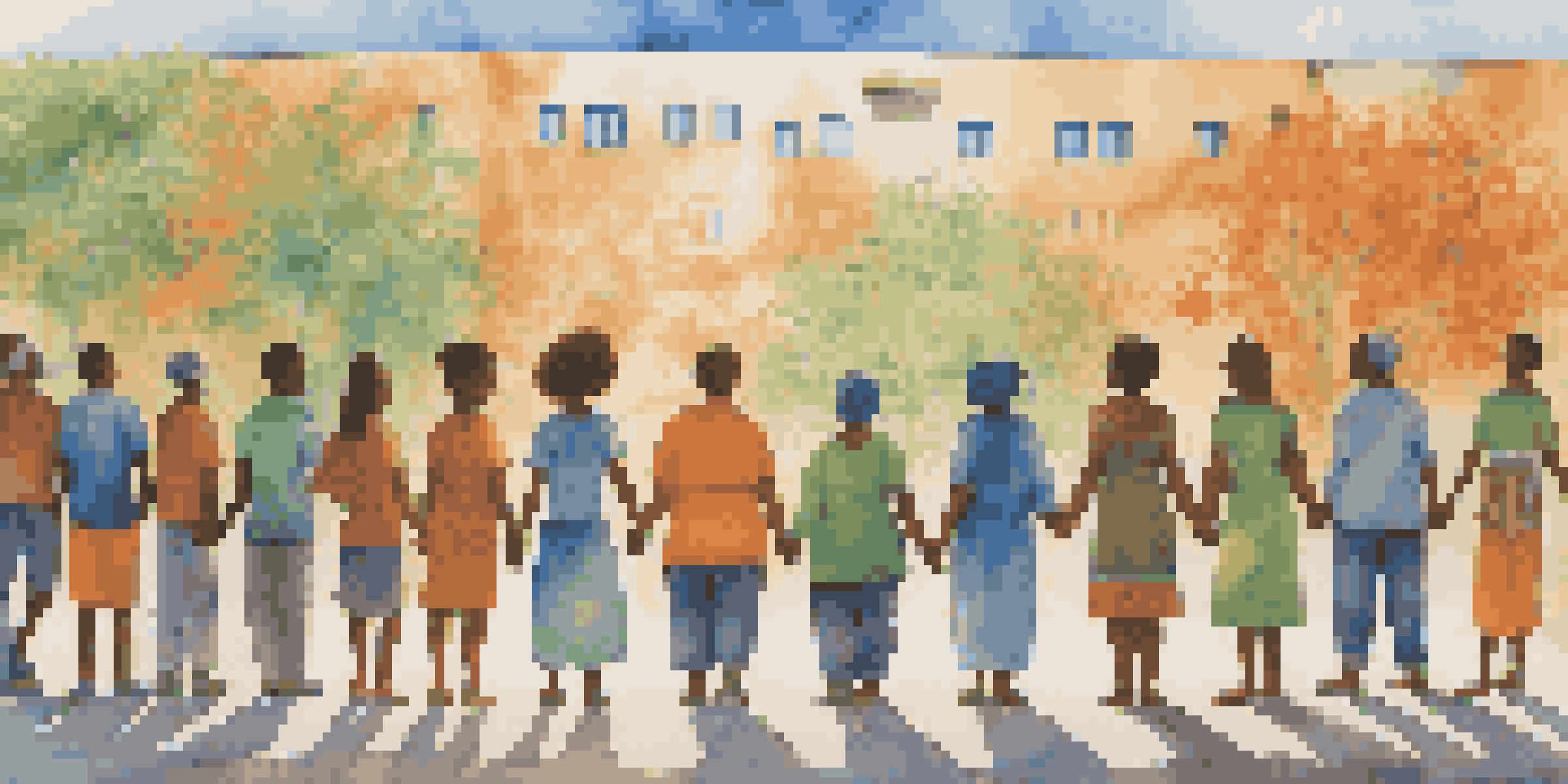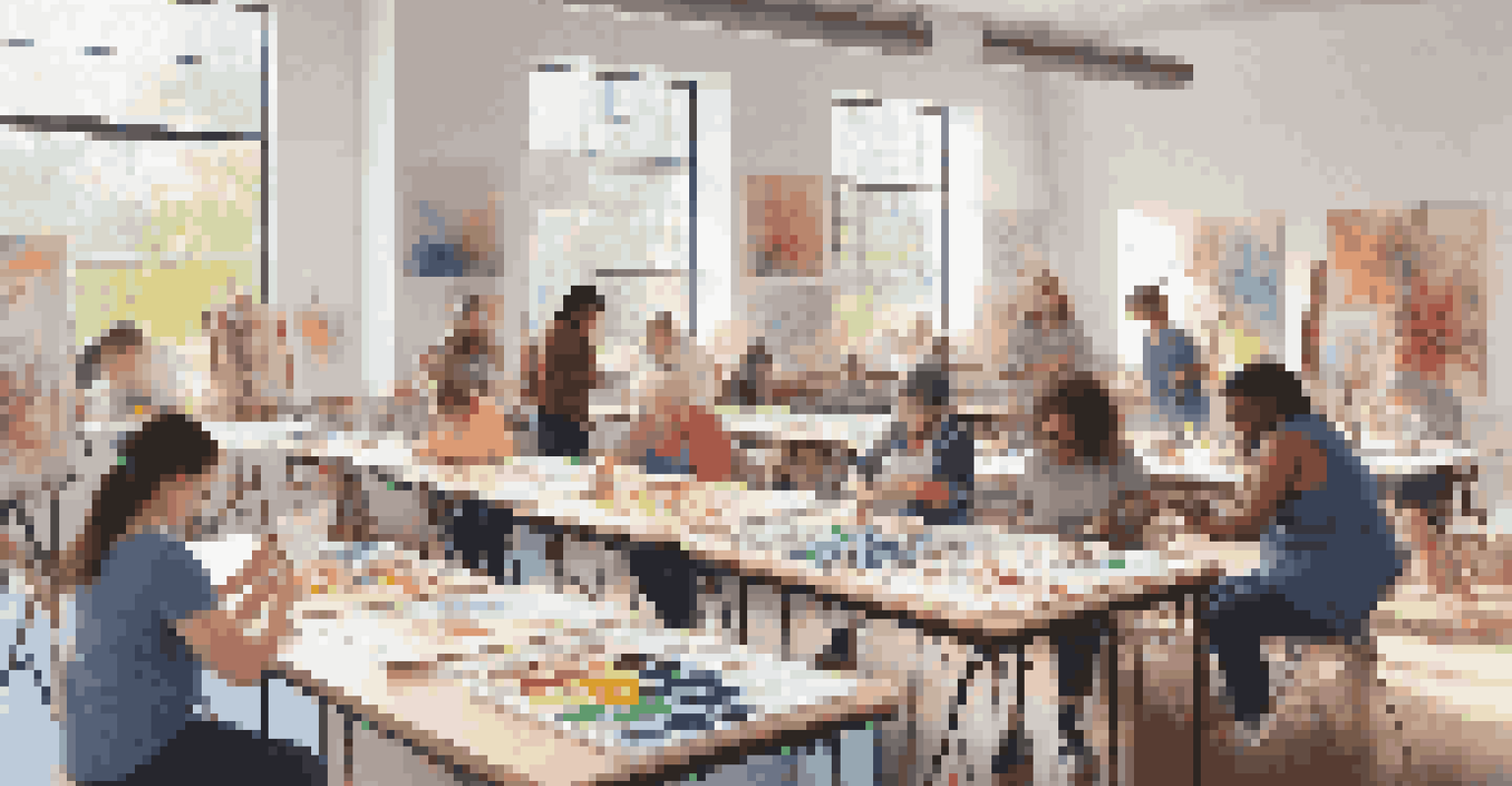Art in the Fight Against Gender-Based Violence

The Role of Art in Social Movements
Art has long been a catalyst for social change, capturing the hearts and minds of people. From protest songs to powerful murals, artistic expressions can convey complex messages in ways that resonate deeply. In the fight against gender-based violence, art serves not just as a medium of expression, but as a vehicle for advocacy and awareness.
Art is a weapon in the battle against ignorance and oppression.
Through various forms, like theater, visual arts, and poetry, artists highlight the struggles faced by victims and survivors. These works foster empathy, encouraging viewers to reflect on their own beliefs and actions. As a result, art can mobilize communities, turning passive observers into active participants in the movement against violence.
Moreover, art transcends language barriers, making it accessible to diverse audiences. It invites conversation, breaking the silence surrounding gender-based violence and creating a safe space for dialogue. This is crucial in sparking change, as understanding and awareness often precede action.
Art as a Form of Healing for Survivors
For many survivors, creating or engaging with art can be a powerful form of healing. Expressive arts therapy allows individuals to process their trauma and emotions in a constructive way. Whether through painting, writing, or dance, survivors can reclaim their narratives and find their voices amidst the pain.

Art provides a safe outlet for feelings that may be difficult to articulate. This cathartic process not only promotes emotional well-being but also fosters resilience. By transforming their experiences into art, survivors can inspire others who may still be in the shadows of their trauma.
Art Advocates for Social Change
Art serves as a powerful medium for raising awareness and mobilizing communities against gender-based violence.
Additionally, community art projects can bring survivors together, creating a supportive network. These collaborations can empower individuals, reminding them they are not alone in their journey. As they share their stories through art, they contribute to a larger narrative that challenges societal norms around gender-based violence.
Raising Awareness through Public Art
Public art installations, such as murals and sculptures, can serve as powerful reminders of the ongoing fight against gender-based violence. They transform everyday spaces into platforms for awareness, prompting passersby to confront uncomfortable truths. These striking visuals can ignite conversations that lead to greater understanding and action.
Creativity takes courage.
For example, a mural depicting survivors can humanize the statistics often thrown around in discussions about violence. It creates a personal connection, compelling viewers to internalize the reality behind the numbers. As a result, public art can shift perceptions and challenge the societal norms that enable violence.
Moreover, public art can also be a rallying point for community events and campaigns. By mobilizing local artists, communities can demonstrate solidarity and commitment to ending gender-based violence. This collective effort not only beautifies the environment but also strengthens community bonds.
The Impact of Performance Art
Performance art uniquely blends storytelling and activism, making it an impactful medium in raising awareness about gender-based violence. Through live performances, artists can engage audiences emotionally, leaving a lasting impression. This format allows for a visceral experience, often stirring feelings that written words alone cannot convey.
For instance, a powerful spoken word piece about personal experiences with violence can resonate deeply with both survivors and allies. The immediacy of performance fosters a connection between the artist and the audience, transforming passive viewers into active participants. This engagement can inspire individuals to reflect on their own roles in combating violence.
Healing Through Creative Expression
Engaging with art allows survivors to process trauma, reclaim their narratives, and foster resilience.
Additionally, performance art often sparks discussions about consent, power dynamics, and societal expectations. By addressing these themes in a creative way, artists can challenge harmful stereotypes and encourage critical thinking. This not only educates but also empowers audiences to take a stand against gender-based violence.
Art Festivals Promoting Gender Equality
Art festivals focusing on gender equality serve as platforms for artists to showcase their work while raising awareness about gender-based violence. These events often feature various artistic expressions, from visual arts to film screenings, creating an immersive experience for attendees. By gathering diverse voices, these festivals amplify the message of equality and justice.
Moreover, they provide opportunities for workshops and discussions that delve deeper into the issues surrounding gender-based violence. Participants can engage with artists, activists, and educators, fostering a sense of community and shared purpose. This collaborative environment encourages individuals to take action, both within their communities and on a larger scale.
Additionally, art festivals can often attract media attention, further spreading the message about gender-based violence. By showcasing powerful artwork and performances, these events can reach a wider audience, increasing public awareness and support for the cause. In this way, art becomes a unifying force, bringing people together to advocate for change.
Digital Art as a Modern Advocacy Tool
In the digital age, art has found new avenues for expression and activism. Social media platforms allow artists to share their work with a global audience, raising awareness about gender-based violence at an unprecedented scale. Viral campaigns often incorporate powerful visuals that resonate with viewers and encourage them to share, amplifying the message further.
Digital art can take many forms, from graphic design to animated videos, making it accessible to a wide range of audiences. This versatility allows artists to experiment with different styles and messages, capturing the attention of those who might not engage with traditional forms of art. The immediacy of digital platforms ensures that the conversation around gender-based violence remains current and relevant.
Digital Platforms Amplify Voices
In the digital age, artists leverage social media to share impactful messages about gender-based violence globally.
Furthermore, online galleries and virtual exhibitions can showcase diverse perspectives from around the world. This global representation fosters a sense of solidarity among those advocating for gender equality. By leveraging technology, artists can create impactful movements that challenge societal norms and inspire change.
Collaborative Art Projects for Change
Collaborative art projects bring together artists, activists, and community members to create meaningful works that address gender-based violence. These projects often involve the participation of survivors, allowing them to share their stories and contribute to the creative process. This inclusivity fosters a sense of ownership and empowerment among participants.
By working together, individuals can develop a deeper understanding of the issues at hand. As they share their experiences and perspectives, they create a rich tapestry of narratives that challenge stereotypes and promote awareness. The resulting artwork can serve as a powerful statement against gender-based violence, resonating with audiences on multiple levels.

Additionally, these projects can lead to ongoing initiatives that support survivors and advocate for change. By building a community around art, participants can continue to work together long after the project concludes. This sustained collaboration not only strengthens relationships but also maintains momentum in the fight against gender-based violence.